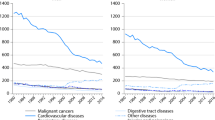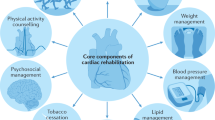Summary
The aim of this analysis is to survey the general demand and current supply of cardiac rehabilitation in Austria on the basis of best evidence practice and to produce recommendations for a cost-effective structure of the entire cardiac rehabilitation system.
Following the standards of indication of the Austrian Society of Cardiology an analysis of demand of cardiac rehabilitation has been carried out and juxtaposed with the current supply of facilities for cardiac rehabilitation. According to hospitalisations in the year 2000, 11,630 patients per annum would require inpatient phase II rehabilitation, 6,270 patients institutional based outpatient phase II rehabilitation and 14,319 patients institutional based phase III rehabilitation.
In the year 2000, 14,746 patients received treatment in the 9 Austrian inpatient cardiac rehabilitation centres. This number is compared with an annual demand of 11,630 admissions for phase-II treatment. It follows that an equilibrium can be argued for the supply of and demand for inpatient cardiac rehabilitation in Austria.
At present, 10 approved institutions in Austria offer outpatient cardiac rehabilitation services. The maximum number of positions for treatment per institution is currently 200–250. Consequently, maximally 2,000–2,500 patients per annum can be treated. In comparison, there exists a calculated demand for 6,270 patients in institutional based outpatient phase II rehabilitation and 14,319 patients in institutional based phase III rehabilitation. Altogether this amounts to a demand for 20,588 positions for treatment per annum.
In Austria, the expenditures for inpatient phase II rehabilitation of a patient given an average duration of stay of 28 days, are ∈ 4,774.-. Presuming 100% compliance, the institutional based outpatient phase II rehabilitation program costs ∈ 2,760.- per patient. The costs for institutional based phase III rehabilitation services are ∈ 2,990.- per patient. This number is accompanied by a potential effective reduction of risks for the patients and a potential effective reduction of costs for the carrier as the number of rehospitalisations and recurrent procedures would decrease significantly.
At present, the supply of cardiac rehabilitation in Austria is sufficient for inpatient phase II, but insufficient for the institutional based outpatient phase II and mainly phase III. Thus, a striking asymmetry exists between supply and demand. In view of the enduring effects of institutional based phase III rehabilitation, the individual and social use and finally the expected efficiency in terms of costs, this program should at least be offered without limits to all eligible patients.
Zusammenfassung
Ziel dieser Arbeit ist es, den allgemeinen Bedarf und das derzeitige Angebot an kardiologischer Rehabilitation in Österreich auf der Basis der Evidenz in der Literatur zu erheben und daraus Empfehlungen für eine kosteneffektive Struktur des gesamten rehabilitativ kardiologischen Versorgungsbereiches zu erarbeiten.
Den Indikationsrichtlinien der Österreichischen Kardiologischen Geselschaft folgend wurde eine Bedarfsanalyse für die kardiologische Rehabilitation durchgeführt und dem derzeitigen Angebot an kardiologischen Rehabilitationseinrichtungen gegenübergestellt. Ausgehend von den Krankenhausaufenthalten des Jahres 2000 würden jährlich 11.630 Patienten eine stationäre Phase II Rehabilitation, 6.270 Patienten eine ambulante Phase II-Rehabilitation und 14.319 Patienten eine Phase III-Rehabilitation benötigen.
In den 9 kardiologischen Rehabilitationszentren Österreichs wurden im Jahr 2000 14.746 Patienten stationär behandelt. Demgegenüber steht ein jährlicher Bedarf von 11.630 stationären Phase II-Behandlungsplätzen. Somit ist der Bedarf und das Angebot der stationären kardiologischen Rehabilitation in Österreich gut ausgeglichen.
Zurzeit beiten 10 akkreditierte Institute in Österreich eine ambulante kardiologische, Rehabilitation an. Die maximale Anzahl von Behandlungsplätzen pro Institution beträgt dzt. 200–250. Somit können maximal 2.000–2.500 Patienten jährlich behandelt werden. Demgegenüber besteht ein berechneter Bedarf für 6.270 Patienten in der Phase II-Rehabilitation und für 14.319 Patienten in der Phase III-Rehabilitation. Das ergibt zusammen einen Bedarf von 20.588 Behandlungsplätzen pro Jahr.
Die Ausgaben für die stationäre Phase II-Rehabilitation eines Patienten bei einer durchschnittlichen Aufenthaltsdauer von 28 Tagen belaufen sich in Österreich auf XXX 4.774,-. Geht man von einer 100%-igen Compliance aus, kostet das ambulante Phase II-Rehabilitationsprogramm XXX 2.760,-pro Patient. Die Kosten für das Phase III-Rehabilitationsprogramm betragen XXX 2.990,- pro Patient. Diesem Betrag zugute steht für die Patienten eine potentiell wirksame Risikoreduktion und für den Träger bedingt durch die Abnahme von Rehospitalisationen und Wiederholungseingriffen eine potentiell wirksame Kostenreduktion.
Das zur Zeit bestehende Angebot an kardiologischer Rehabilitation in Österreich ist für die stationäre Phase II ausreichend, jedoch für die ambulante Phase II und insbesondere für die Phase III ungenügend. Hier besteht ein bemerkenswertes Missverhältnis zwischen Angebot und Nachfrage. In Anbetracht der Nachhaltigkeit der Wirkung der Phase III-Rehabilitation und dem zu erwartenden medizinischen und ökonomischen Nutzen sollte zumindest dieses Programm allen in Frage kommenden Patienten in uneingeschränktem Umfang angeboten werden können.
Similar content being viewed by others
Literatur
WHO and T.R.S. 831 (1993) Rehabilitation after cardiovascular diseases, with special emphasis on developing countries. World Health Organization Geneva
Gobe AJ, Worcester MUC (1999) Best practice guidelines for cardiac rehabilitation and secondary prevention. Heart Research Centre, Melbourne, on behalf of Department of Human Services Victoria
Scottich Guideline Intercollegiate Network (SIGN) (2002) Cardiac rehabilitation. A National Clinical Guideline. SIGN Publication No 57. www.sign.ac.uk
US Department for Health and Human Services. Agency for Health Care Policy and Research (AHCPR) (1995) Cardiac Rehabilitation: Clinical Guideline Number 17. AHCPR Publication 96-0672
Dietz R, Rauch B (2003) Leitlinie zur Diagnose und Behandlung der chronischen koronaren Herzerkrankung der Deutschen Gesellschaft für Kardiologie — Herz- und Kreislaufforschung (DGK) www.dgpr.de
O’Connor GT, Buring JE, Yusuf S, Goldhaber SZ, Olmstead EM, Paffenbarger RS (1989) An overview of randomized trials of rehabilitation with exercise after myocardial infarction. Circulation 80: 234–244
Oldridge NB, Guyatt GH, Fischer M, Rimm AR (1988) Cardiac rehabilitation after myocardial infarction: combining data from randomized clinical trials. JAMA 260: 945–980
Jolliffe JA, Rees K, Taylor RS, Thompson D, Oldridge N, Ebrahim S (2001) Exercise-based rehabilitation for coronary heart disease (Cochrane Review). In: Cochrane Library. Update Software. Oxford
Ades PA, Huang D, Weaver SO (1992) Cardiac rehabilitation participation predicts lower rehospitalization costs. Am Heart J 123: 915–921
Levin LA, Perk J, Hedback B (1991) Cardiac rehabilitation — cost analysis. J Intern Med 230: 427–434
Kurz RW, Uhlir H (2001) Einsparungspotential bei Antihypertensiva durch integriertes ambulantes Hypertonikertraining. J Hyperton 3: 20–37
Buchwalsky G (2002) Langzeitwirkungen der Nachsorge in einer ambulanten Herzgruppe. Eine Fall-Kontrollstudie. Z Kardiol 91: 139–146
Weiss O (1999) Sport und Gesundheit. Die Auswirkungen des Sports auf die Gesundheit — eine sozioökonomische Analyse. Bundesministerium für Soziale Sicherheit und Generationen
NHS Centre for Reviews and Dissemination, University York (1998) Cardiac rehabilitation. Effective Health Care 4: 0965–0288
Benzer W, Oldridge NB (2001) Current concepts in cardiac rehabilitation: medical considerations and outcomes evaluations. J Clin Basic Cardiol 4: 211–219
Willich SN, Muller-Nordhorn J, Kulig M, Binting S, Gohlke H, Hahmann H, Bestehorn K, Krobot K, Voller H (2001) Cardiac risk factors, medication, and recurrent clinical events after acute coronary disease. A prospective cohort study. European Heart J 22: 307–313
E-upuroaspire II Study Group (2001) Lifestyle and risk factor management and use of drug therapies in coronary patients from 15 countries; principal results from EUROASPIRE II Euro Heart Survey Programme. Eur Heart J 22: 554–572
Benzer W, Simma L, Stocker G (1987) Rehabilitation nach Myokardinfarkt in ambulanten Koronargruppen. Springer, Berlin Heidelberg New York Tokyo
Greiner-Pesau B, Schmoll K, Uhlir H: „Guidelines für die ambulante kardiologische Rehabilitation in Österreich” der Arbeitsgruppe für kardiologische Rehabilitation und Sekundärprävention der Österreichischen kardiologischen Gesellschaft. Veröffentlicht auf der Website der ÖKG: www.atcardio.at
Unger F (1999) Interventionen am Herzen: Herzchirurgie. Herzkatheter und PTCA in Österreich. European Heart Institute. Salzburg
Oldridge NB (1982) Compliance and exercise in primary and secondary prevention of coronary heart disease: a review. Prev Med 11: 56–70
Benzer W, Bitschnau R, Simma L (1995) Ambulante Rehabilitation nach Herzinfarkt in Österreich. Wien Klin Wochenschr 107: 766–770
Hughes AR, Gillies F, Kirk AF, Mutrie N, Hillis W, Maclntyre PD (2002) Exercise consultation improves short-term adherence to exercise during phase IV cardiac rehabilitation. J Cardiopulm Rehabil 22: 421–425
Bjarnason-Wehrens B (1997) Das Kölner Modell der ambulanten kardialen Rehabilitation. Herz Kreisl 29: 224–231
Rost R (1998) Ambulante vs. stationäre Rehabilitation nach stattgehabtem Myokardinfarkt — pro ambulante Rehabilitation. Z Kardiol 87: s222-s224
Bjarnason-Wehrens B (1997) Ambulante kardiale Rehabilitation der Phase II — Kölner Modell. MMW 139: 311
Vanhees L, McGee HM, Dugmore LD, Schepers D, van Daele P, Carinex Working Group: CArdiac Rehabilitation INformation EXchange (2002) A representative study of cardiac rehabilitation activities in European Union Member States: the Carinex survey. J Cardiopulm Rehabil 22: 264–272
Baessler A, Hengstenberg C, Holmer S, Fischer M, Mayer B, Hubauer U, Klein G (2001) Long-term effects of inhospital cardiac rehabilitation on the cardiac risk profile. A case-control study in pairs of siblings with myocardial infarction. Eur Heart J 22: 1111–1118
Stahle A, Mattsson E, Ryden L, Unden A, Nordlander R (1999) Improved physical fitness and quality of life following training of elderly patients after acute coronary events. A 1 year follow-up randomized controlled study. Eur Heart J 20: 1475–1484
Marchionni N, Fattirolli F, Fumagalli S, Oldridge BN, Del Lungo L, Morosi L, Burgisser C, Masotti G (2003) Improved exercise tolerance and quality of life with cardiac rehabilitation of older patients after, myocardial infarction: results of a randomized, controlled trial. Circulation 107: 2201–2206
Drexel H, Gaul GB, Grimm G, Klein W, Kleemann L, Leisch F, Miczoch J, Pichler M, Sailer S, Slany J, Steinbach K, Tragl KH, Mori M, Kühn P (1999) Secondary prevention following coronary intervention. Survey of 13 intervention centers in Austria. Wien Klin Wochenschr 111: 643–647
Gohlke H (1995) Benefits and risks of physical activity in patients with coronary heart disease. Wien Klin Wochenschr 107: 760–765
Author information
Authors and Affiliations
Corresponding author
Rights and permissions
About this article
Cite this article
Benzer, W., Mayr, K. & Abbühl, B. Kardiologische Rehabilitation in Österreich. Eine Bedarfsanalyse. Wien Klin Wochenschr 115, 780–787 (2003). https://doi.org/10.1007/BF03040503
Received:
Accepted:
Issue Date:
DOI: https://doi.org/10.1007/BF03040503




